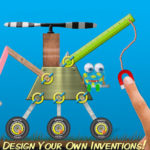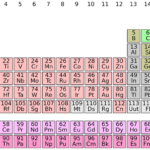 Finding webtools for high school classes requires a different set of metrics than those that apply to lower and middle school searches. Teachers who specialize in preparing students for college and career instinctively want tools that extend learning, support lesson plans, and simplify concepts taught in the curriculum. Of course they do! By high school, the pressure to prepare students for their future is immense. This is the final chance to provide students with the knowledge they require to succeed in the game called life.
Finding webtools for high school classes requires a different set of metrics than those that apply to lower and middle school searches. Teachers who specialize in preparing students for college and career instinctively want tools that extend learning, support lesson plans, and simplify concepts taught in the curriculum. Of course they do! By high school, the pressure to prepare students for their future is immense. This is the final chance to provide students with the knowledge they require to succeed in the game called life.
Let me put that in pedagogic terms. If you’re familiar with the SAMR Model, you know it refers to the way technology tools can be used to enrich classrooms. This starts at a basic level of replacing traditional tools (like an atlas) and ends where technology provides experiences students couldn’t get without technology. Here’s how it works:
S (Substitution) — use technology in place of a traditional tool. For example, take notes digitally rather than with paper and pencil
A (Augmentation) — technology functionally improves the traditional learning approach. For example, notetaking may include audio and images as well as text
M (Modification) — use technology to enhance learning in ways that weren’t possible before. For example, students can share their notes and comments with each other creating a collaborative and energized learning environment
R (redefinition) — students use tech tools to accomplish learning that wasn’t possible with the traditional approach. For example, students use interactive maps to explore a geographic environment as though they were there.
The high school teachers I know want tools that contribute significantly to a student-centered learning ecosystem and that enrich learning with experiences they couldn’t have without the technology (modification and redefinition). They aren’t interested in replacing the usual tools or facilitating rote drills. Time is too short and the consequences too significant. To that end, here are six worthy websites and digital tools that will make high school classes more engaging, more effective, and more student-centered than ever:
 1 Monster Physics®
1 Monster Physics®
Fee ($1.99 currently), iOS only
Monster Physics is a building game that lets kids ten and above explore the principles of physics. They can build their own car, crane, rocket ship, plane, helicopter, or tank by combining over sixty-eight different parts including wheels, rockets, propellers, cannons, magnets, claws, wings and more. These projects can be built from metal, wood, plastic, rubber, or even ice, connecting the parts by welding them, drawing a rope or chain between them with a finger, or using special dynamic joints. Once the invention is complete, Monster Physics will render it with a built-in physics engine and let students operate their creation in real time. Monster Physics comes with fifty missions for students to solve and includes simple tutorials as well as clever challenges. Many of the missions are open-ended and can be solved with a wide variety of different solutions so students can play them over and over again. Along the way, students learn common physics terms in context, hone problem-solving and creative-thinking skills, and discover that physics is fun.
The app includes no in-app purchases, no social media connections, and no advertising.
2 Crash course
Free, web-based or DVD
Crash Course is an immensely-popular YouTube video stream (with over a half a million viewers and counting) offered by two brothers who record weekly ten-fifteen minute videos addressing a wide variety of AP high school curriculum topics such as physics, astronomy, biology, history, chemistry, US history, World history, and computer science. Each stream has as many videos as have been posted in the two years the program has been around. Content is fast-paced and engaging, the brothers enthusiastic and passionate presenters. The videos are well-produced with professional sound effects and animations that contribute to learning the topics. They can be shown in the classroom or assigned as homework though they include no tests or other assessments.
3 Periodic Videos
Free, web-based
Periodic Videos is a growing collection of not only the 118 elements on the Periodic Table but Nobel prize winners, science news, interesting molecules, Slow-motion Chemistry, radioactivity, and more. Each video is engaging, quick, and short, narrated by the eccentric and knowledgeable Professor Poliakoff and his team at the University of Nottingham, England. With over 680 million views, it’s a winner for every science teacher. Besides the venerable Periodic Table, the site links to short video clips on the sixty symbols used in physics and astronomy (I have no idea what these are; I need to click that link), the science behind what we eat and drink, and the molecular basics of well-known drugs such as aspirin and morphine.
4 Concordia Consortium
Free, web-based
The Concordia Consortium, founded in 1994, is an educational research and development organization with the goal of improving K-14 teaching and learning through technology. This site — Learn Concord — provides a collection of their best resources for science, math, and engineering education and includes STEM lesson plans in the areas of physics, chemistry, life science, engineering, earth and space, and mathematics. Focused collections include Building Models, Electron Technologies, Evolution Readiness, High Adventure Science, Graph Literacy, and Geode. It can be filtered by type (activity, model, or sequence) and grade (from elementary to higher education).
5 Engineering games
Free, web-based and mobile
TryEngineering is a well-built website on all-things engineering for high school students interested in pursuing this field as well as parents, teachers, and guidance counselors providing advice to future engineers. It includes how to become an engineer, lesson plans for teachers, and — this article’s favorite: Games. Games vary from instructional to entertaining and include topics like What Kind of Engineer are you?, Questioneering (with a leaderboard tracking all players), Bionic Arm Design Challenge, Design a Parachute, Fidget Factory, and Station Spacewalk Game. Mobile games include NASA Satellite Insight, Lunar Electric Rover simulator, Hopscotch, TeslaTown, and more. There is something for everyone on this site, all with the goal of demystifying engineering.
6 SciToys
Free, web-based
SciToys shows kids how to make toys at home that demonstrate fascinating scientific principles using common household materials, often in only a few minutes. Toys include Franklin’s Bells, Curie-effect heat engine, the Gauss Rifle, a Railgun, and more. Topics include magnetism, electromagnetism, electrochemistry, radio, thermodynamics, aerodynamics, light and optics, biology, mathematics, and computers. This is a fascinating site that explains complicated principles in words high schoolers can understand.
***
If your students feel like science is complicated, out of their mental range, and boring, introduce them to these six sites. They’ll change their minds.
Jacqui Murray has been teaching K-18 technology for 30 years. She is the editor/author of over a hundred tech ed resources including a K-12 technology curriculum, K-8 keyboard curriculum, K-8 Digital Citizenship curriculum. She is an adjunct professor in tech ed, Master Teacher, webmaster for four blogs, an Amazon Vine Voice, CSTA presentation reviewer, freelance journalist on tech ed topics, contributor to NEA Today, and author of the tech thrillers, To Hunt a Sub and Twenty-four Days. You can find her resources at Structured Learning.



































